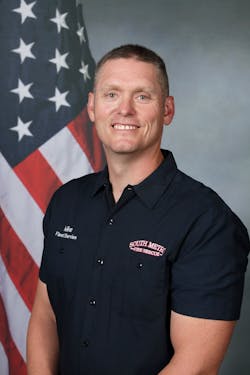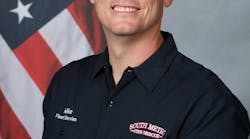Michael Adams, fleet supervisor for South Metro Fire Rescue Authority (SMFRA) in Centennial, Colo. has always been intrigued by electronics. When he was 10 years old, Adams took apart the motor on the go-kart his dad built for him and his brother. “I took the motor apart because I wanted to see how it worked,” he said.
Adams was selected as the 2015 Emergency Vehicle Technician of the Year by Firehouse and the award is sponsored by Smeal. You can find the top five EVT winners here.
Adams graduated from the Denver Automotive and Diesel College in 1997 and spent eight years working on over-the-road trucks before joining Parker Fire Department in 2005. He is a Fire Apparatus EVT Level III Master and ARFF EVT Level III Master Technician, and passed his EVT M1 Level I Supervisor Certification. Adams has been actively involved in the Colorado Emergency Vehicle Technicians Association’s annual Fire Mechanics Academy. This month, Adams was promoted to Fleet Supervisor for SMFRA. He is married, with four children, and is pursuing his bachelor’s degree.
In nominating Adams for the 2015 Emergency Vehicle Technician of the Year award, Brian Brown, fleet bureau chief for SMFRA, wrote, “Michael believes being proactive with a preventive maintenance schedule is the foundation to reducing apparatus downtime and increasing availability.”
Firehouse: In a busy department like South Metro, how have you managed the time to pursue EVT certifications?
Adams: I first became Automotive Service Excellence (ASE) certified in 1999, so obtaining the EVT certification was fairly easy. When I came to work at Parker I was already an ASE Master Technician. Part of being employed by South Metro is that we have to be at least EVT I certified. They compensate us for our certifications, so pretty much everybody in our shop carries one masters, if not two.
South Metro has been great on staying current. We budget every year to keep the technicians updated on the latest in apparatus. Brian Brown, fleet bureau chief, is always willing to give us the tools we need to stay up on the trends in the fire service. We keep equipment quite a while, so we need to stay up with it. It seems like the fire service is always five to 10 years behind the private sector with technology.
Firehouse: Don’t you think the fire service is catching up with the private sector in advanced vehicle technology?
Adams: I think the larger departments are catching up. We have got neighboring departments here in the county that are running 20-year old frontline rigs because they don’t have the money like larger departments to stay on top of technology. A lot of larger departments like us are purchasing a lot of new vehicles over the next few years and so we’re catching up with the technology, which in some ways is good and some ways bad with all the new EPA changes.
Firehouse: We understand that you are quite proficient at diagnostics and a resource for other EVTs. How did you develop those skills?
Adams: I think it’s always been my love for a challenge, back to my dealership days working with all CAT and Cummins motors. They bring (the truck) up to you to do the diagnostics and a lot of times we didn’t have the support, so it was just a lot of trial and error.
I have a different way I troubleshoot and some people think it’s crazy but it’s worked for more than 20-plus years. If I’m troubleshooting a "check engine" light, I will stay step-by-step with the troubleshooting tree and a lot of guys won’t do that. I look at it that somebody a lot smarter than me put together the troubleshooting tree and they have a lot better idea of how to do it. Sometimes it’s just my experience or something I have seen before and is very common. I keep that in mind that I have seen this before, but stay true to the troubleshooting tree.
Firehouse: I understand aerials are another specialty of yours.
Adams: A few years back, we ran four frontline towers and a lot of guys didn’t like working on them. I just viewed it as another challenge. For a while I was the only guy working on aerials and became very proficient. I developed a great relationship with the crews at those stations to the point where the crew would call me direct.
When I look at aerials, they’re not very complex. A lot of people are afraid of aerials, but I just look at them as another cog in the wheel in fire apparatus.
Firehouse: You are also Red Card certified. How did that come to be?
Adams: We had an incident three or four years ago, a very large Type 1 incident just north of us and we had some units on deployment. We had a unit go down and the first mechanics couldn’t get it going, but it was fortunate that our after-hours mechanic was a Red Card firefighter for a neighboring department. It became obvious that we might have to go behind the lines, so we should understand fire behavior and understand what we’re going into. Each incident commander will say we can’t go back there because we’re not certified. So all but one technician in our shop is Red Card certified. It’s one of thing we keep up on an annual basis.
Firehouse: What is one of the biggest challenges you face in your position?
Adams: Keeping up with technology and making sure the department understands when budget processes comes around why we spend the money we spend on diagnostic software. We run Fords on our light duty, so we purchased the Ford Integrated Diagnostic System (IDS) software. We probably spend around $6,000 a year to keep up the licenses with our diagnostic software. Somebody not knowing our business will look at that item and ask why we are spending that amount of money. If your records are not accurate and something happens, they are going to hang you out there if you can’t prove your work.
We purchased a very large van and starting in January we’re going to have a guy full-time on the road to see the vehicles more often and take care of day-to-day repairs to try and be more proactive on maintenance trends. If we’re starting to see some engine component wear, we can pre-order parts so when the vehicle comes in for a PM, we can have those parts and turn the vehicles around faster. My goal is to do dry PMA’s on our specific equipment in the field—like ARFF and tenders--that regularly don’t see a lot of road time or hours. They don’t need to come into the shop, but I’d like to see them one time a year so when the vehicle does respond, it will be able to do its job and not have an issue.
Firehouse: Any comments to share with other EVTs?
Adams: First, stay up with the latest technology and trends. I’m a young guy so I know that some of the older folks struggle with the technology because they didn’t come up with it. Every year there’s something new and greater but if we don’t stay up on it we can’t stay proficient. And stay up in touch with the EVTs. It’s a great resource when the NFPA makes changes.







